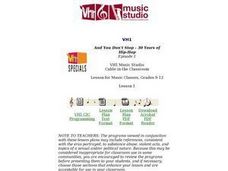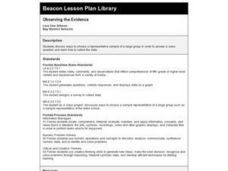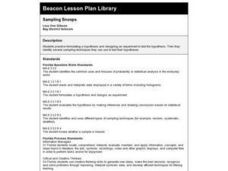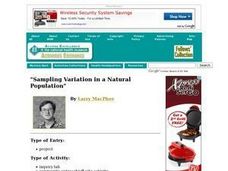Curated OER
And You Don't Stop-30 Years of Hip-hop
High schoolers identify the musical genre of Hip-Hop and make a connection with other styles of music. A time line of musical styles is developed and discussed.
Curated OER
Observing the Evidence
Fifth graders explore how to do research from a large group. They explore how to choose a representative sample and collect data from it.
Curated OER
Probability with Number Cubes
Second graders make sampling predictions, predict outcomes and explore probability through experimentation.
Curated OER
Sampling Snoops
Students practice formulating a hypothesis and designing an experiment to test the hypothesis. They identify several sampling techniques they can use to test their hypotheses.
Curated OER
Sampling Rocks
Young scholars study about sampling through an investigation of rocks found in the schoolyard. They sort the collected rocks by characteristics such as size, weight, and color, to see if any generalizations can be made about the types of...
Curated OER
Math Applications 2
In this probability worksheet, students solve 1 word problem with three different parts to it. First, they find the probability of drawing an ace from a deck of cards. Then, students determine the probability that they will draw an ace...
Curated OER
Which Pizza
Seventh graders investigate the data related to finding the favorite type of pizza that 7th graders eat. The data is analyzed taken from a survey that focuses on the toppings of the pizza and not the brand. Students practice the sampling...
Curated OER
Particulate Observation
Students examine samples of common dust from their homes and school under a microscope. Students describe their samples including the location from where they were collected, and compare their samples to make hypotheses about their...
Curated OER
Creating A Document With A Table, Chart, and Watermark
Pupils demonstrate to instructor how to add a border and shading to a paragraph. They also insert a section break and create a header different from a previous header.
Students design a poster showing characters formatted using the font...
Curated OER
Spring Collecting and Identifying Bumble Bees
Students collect bumble bees in the field, record data, pin and label specimens, answer conclusion questions, and send specimens to research leaders for verification. They improve their ability to work in research teams. Students...
Curated OER
Sampling Variation in a Natural Population
Learners examine the phenotypic variation within a natural population of a single species. They collect data on the species and analyze the data using statistical/spreadsheet software. Students interpret their results and present their...
Curated OER
The Archaeology of Cactus Ruin
Students simulate archaeologists by excavating a paper site. In groups, they use a sampling strategy to determine information about the people who lived at the site.
Curated OER
Take a Dip: The Water in our Lives
Students collect water samples from local freshwater sources and test for pH, dissolved oxygen, nitrates, macroinvertebrates, phosphates, and coliform bacteria in order to determine water quality for each source.
Curated OER
Fisheries Research Methods
Students explore how scientists keep track of fish populations and why it is important to do so. They describe three methods currently used to sample fish populations. They participate in activities to simulate several of the sampling...
Curated OER
Statistical Specimens
Third graders are introduced to statistical vocabulary. They complete an online activity that asks them to calculate the mean, median and mode for a set of data.
















